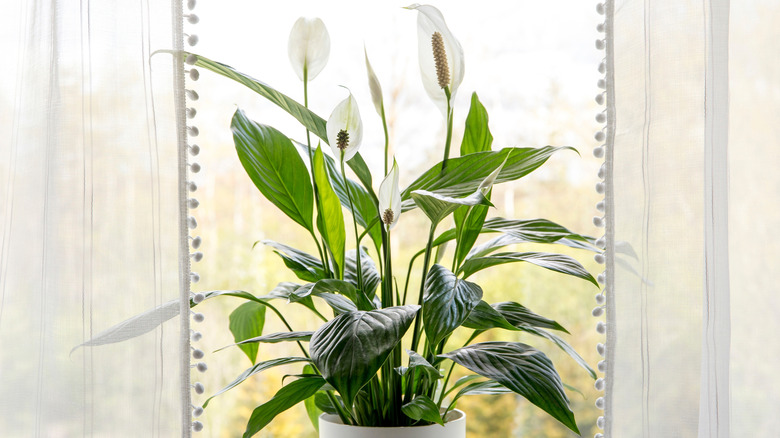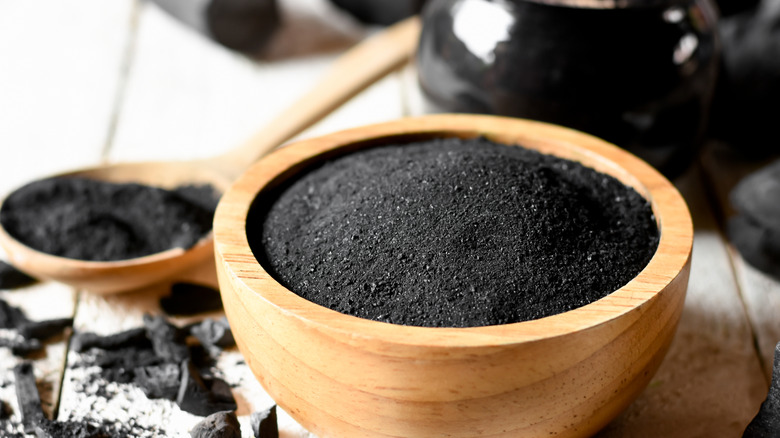Can't Afford A New Air Purifier? Here Are Cheap Alternatives To Consider Instead
We may receive a commission on purchases made from links.
In today's world, fresh air is no longer a given. It's something we all need and deserve, but the cost of a high-quality air purifier isn't within everyone's budget. The air purifiers recommended by the Asthma and Allergy Foundation of America, such as the Dyson Pure Cool Air Purifying Fan, can retail for around $460. Thankfully, you don't need to spend a fortune to breathe clean and safe air at home. Some natural products such as houseplants and activated charcoal are scientifically proven to remove contaminants, including bacteria and mold, from the environment. Experts have designed innovative DIY filters you can put together with a few supplies to help improve the air quality in your home.
Air pollution has wide-ranging negative consequences for human health. According to the World Health Organization (WHO), breathing harmful particles causes inflammation and immunosuppression in the body, increasing the risk of heart disease, stroke, pneumonia, adverse effects during pregnancy, and lung cancer. With wildfire smoke and fossil fuel emissions in our atmosphere, the need for clean air has never been greater. If you do a quick online search of air purifier alternatives, you will see that there are many online claims that beeswax candles and Himalayan salt lamps are the secret to purer air, but the truth is that there's little scientific evidence to prove it. However, there are many other air purifiers out there that won't break the bank, with research-based proof to back up their claims.
Natural alternatives to expensive air purifiers
Filling your home with greenery is among the most effective ways to purify the air naturally. Plants have a sophisticated internal system for removing airborne pollutants from their environment, and some indoor plants are especially good for this. Plants that help purify the air in your home include peace lilies, Areca palms, philodendrons, Golden pothos, Snake plants, and Arrowhead vines. All of these are scientifically proven to remove contaminants, bacteria, mold, and volatile organic compounds (VOCs) from their environment, according to a 2021 study published in Frontiers in Molecular Bioscience.
Certain essential oils have also been proven to reduce airborne bacteria. A 2019 Journal of Environmental Science and Health study found that lemon and silver fir essential oils dispersed in hospital rooms reduced the concentration of airborne bacteria and fungi. Within the first two hours of dispersing the oil, the lemon blend reduced microbial contamination in the room by 40%, and the silver fir blend was 30% to 60% effective. Make the air in your home safer and cleaner by adding lemon and silver fir essential oils to your diffuser.
Activated carbon, also called activated charcoal, is another natural substance you can use to purify the air in your home. Activated charcoal has been used as a natural air and water purifier for centuries and is widely used today. Your water filtration system likely has a carbon component, as activated charcoal can remove contaminants like chlorine from drinking water. A study by the U.S. Department of Energy found that filters containing activated carbon were more effective at purifying indoor air than non-carbon air filters.
How to make your own air purifier at home
Instead of emptying your wallet for a store-bought air purifier, you can make your own using activated charcoal and a few basic supplies. Purchase activated charcoal granules high in iodine, which is proven to boost its antiviral and antibacterial properties. Place around 200 grams of the charcoal granules into a sealed, breathable canvas bag. Next, put the canvas bag inside of a jute bag, seal the bag, and hang it in your home. If the container is breathable enough, the charcoal granules will absorb harmful particles and odors from the atmosphere for up to 20 days. After that, the granules should be replaced.
For combating wildfire smoke, the Puget Sound Clean Air Agency has developed an effective DIY air purifier that you can build at home with a box fan and a standard furnace filter. Using a drill and metal brackets, attach the furnace filter to the back of the fan with the arrow pointing in the direction of the fan's airflow. Ensure that the fan and the filter are the same size and that the filter is placed directly against the fan. According to a test performed by the agency, this DIY purifier will significantly help to eliminate small particles and black carbon pollution from the atmosphere, which are the most common air pollutants caused by wildfire smoke.


